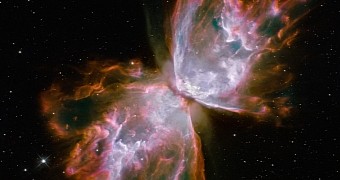This past October 13, the European Space Agency woke up a wee nostalgic and ended up sharing a positively mind-boggling image of the Butterfly Nebula with the online community.
The image, available next to this article, was obtained back in 2009 with the help of the Hubble Space Telescope. Why the Agency felt like revising it remains a mystery. We can only be grateful it did.
Introducing the Butterfly Nebula
In the description accompanying this stunning Hubble Space Telescope image on the Agency's website, astronomers explain that the Butterfly Nebula, sometimes referred to as the Bug Nebula, is officially known as NGC 6302.
It sits in the constellation Scorpius at a distance of about 3,800 light-years from our planet, and scientists say that it is one of the most complex nebulae thus far discovered and studied.
The Butterfly Nebula's wings might appear delicate and simply gorgeous, but the fact of the matter is that they are nothing short of deadly. Thus, they comprise gas heated to over 36,000 degrees Fahrenheit (nearly 20,000 degrees Celsius).
As if this weren't enough to really freak people out, scientists say that the gas in this nebula's wings is traveling through space at a speed of about 600,000 miles per hour (approximately 965,000 kilometers per hour).
Just to put things into perspective, it need be said that, were somebody capable of reaching this speed, it would only take them 24 minutes to travel from Earth to the Moon. So, yes, the Road Runner ain't got diddly-squat on the gas in this nebula.
The Butterfly Nebula is estimated to measure about 2 light-years from one end to the other. This means that its length is half the distance between our Sun and the star closest to it, a celestial body dubbed Alpha Centauri.
The colors in this image are an indicator of the nebula's chemical makeup. Thus, the red edges indicate the presence of nitrogen, whereas the white splashes closer to the center serve as an indicator of the presence of sulphur. Other colors pin down the location of oxygen, helium and hydrogen gases.
How was this nebula born?
According to scientists with the European Space Agency, the Butterfly Nebula came into being when a star about five times heavier than our Sun reached the end of its life. Thus, the star turned into a red giant, coughed out its outer layers and got terribly hot.
The nebula owes its voluptuous hourglass-like figure to the fact that the gas originating from the dying star escaped more easily from the celestial body's poles than from around its equator. It is estimated that gas forming the Butterfly Nebula's wings was ejected from the dying star's outer layers over a period of time of about 2,200 years.

 14 DAY TRIAL //
14 DAY TRIAL //